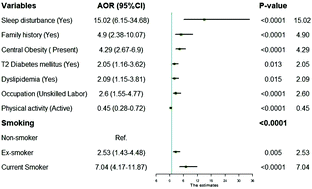Association of smoking with coronary artery disease in Nepalese populations: a case control study
Abstract
There are well-known traditional risk factors for coronary artery disease (CAD). Among them, smoking is one of the most prominent and modifiable risk factors. This study aims to determine the magnitude of smoking as a risk factor for CAD in the Nepalese population. A hospital-based age- and sex-matched case–control study was carried out with a total of 612 respondents. Bivariate analysis showed that the risk of developing CAD in ex-smokers and current smokers was higher (odds ratio (OR): 1.81 (confidence interval (CI): 1.21–2.7) and OR: 5.2 (CI: 3.4–7.97)), with p-values less than 0.004 and <0.00001, respectively, compared to the risk in never smokers. From stratified socio-demographic, cardio-metabolic, behavioural and psychosocial risk factor analysis, smoking was found to be associated with CAD in almost all subgroups. In the subsequent multivariate analysis, adjustment for socio-demographic, cardio-metabolic and psychosocial risk factors showed a steady increase in risk. However, further adjustment for behavioural risk factors (alcohol use and physical activity) showed that the risk was attenuated by 59% in current smokers. After adjusting for the covariates, current smokers and ex-smokers had an increased risk of CAD (OR: 6.64, 95% CI: 3.64–12.12, p < 0.00001; OR: 1.89, 95% CI: 1.08–3.31, p < 0.012, respectively) compared with non-smokers. In conclusion, smoking was found to increase the risk of CAD in the Nepalese population.



 Please wait while we load your content...
Please wait while we load your content...